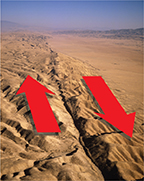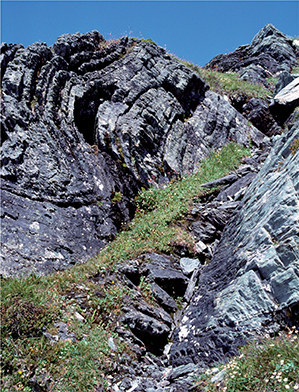As a result of the earthquake, nearly 230,000 people died in Asia and Africa. Many people were killed or injured when coastal areas were hit by a tsunami. A tsunami is a large sea wave generated by an underwater earthquake, volcano, or landslide. When the 2004 Sumatra earthquake ruptured the sea floor, it pushed up a large volume of water, resulting in a tsunami. Figure 32 shows flood damage caused by the deadly tsunami that followed the Sumatra earthquake.
Stress in Earth's Crust
Earthquakes happen because of the ways that plate movements affect the lithosphere. The forces of plate movement cause deformation, or changes in the shape or volume of a mass of rock. Deformation acting on the rocks of the crust is an example of stress. Stress is a force that squeezes rocks together, stretches or pulls them apart, or pushes them in different directions.
One way of applying stress to a material is to try to bend it. If you try to bend a brittle material, such as chalk, it will break. Other sorts of materials, such as copper wire, can bend without breaking.
 As tectonic plates move, they cause stress in the crust, which in turn produces faults and folds.
As tectonic plates move, they cause stress in the crust, which in turn produces faults and folds.
A fault is a break in a mass of rock along which movement occurs. The two slabs of rock on either side of a fault move in relation to each other. Many faults occur along plate boundaries. The San Andreas fault, shown in Figure 33, is part of a transform boundary between the Pacific and North American plates. Along this fault, the crust slides in opposite horizontal directions.
Figure 33 This portion of the San Andreas fault runs through the Carrizo Plain in south-central California. Classifying What type of plate boundary forms the San Andreas fault?

A fold is a bend in layers of rock. Folds form where rocks are squeezed together, but do not break. Rocks tend to fold rather than break when they are under high temperature or pressure. The folds in rock can vary greatly in size. For example, the wavy patterns in some metamorphic rocks that you can hold in your hand are folds. Folds can also be seen in the rock layers that make up a mountain range, as in Figure 34.

What is a fault?
Figure 34 Stress can squeeze rock together, producing folds in layers of rock.





